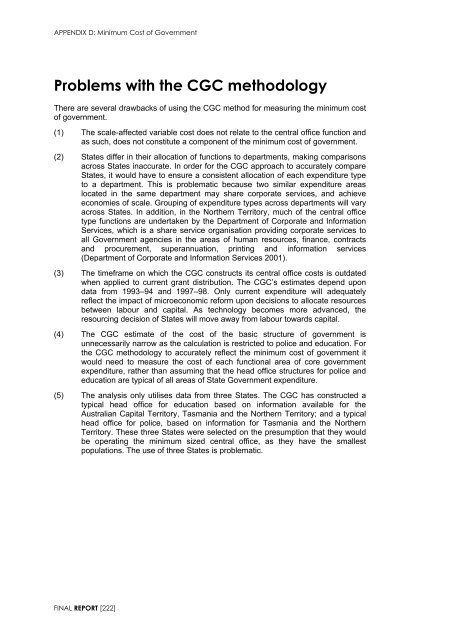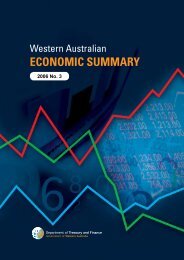Garnaut Fitzgerald Review of Commonwealth-State Funding
Garnaut Fitzgerald Review of Commonwealth-State Funding
Garnaut Fitzgerald Review of Commonwealth-State Funding
Create successful ePaper yourself
Turn your PDF publications into a flip-book with our unique Google optimized e-Paper software.
APPENDIX D: Minimum Cost <strong>of</strong> Government<br />
Problems with the CGC methodology<br />
There are several drawbacks <strong>of</strong> using the CGC method for measuring the minimum cost<br />
<strong>of</strong> government.<br />
(1) The scale-affected variable cost does not relate to the central <strong>of</strong>fice function and<br />
as such, does not constitute a component <strong>of</strong> the minimum cost <strong>of</strong> government.<br />
(2) <strong>State</strong>s differ in their allocation <strong>of</strong> functions to departments, making comparisons<br />
across <strong>State</strong>s inaccurate. In order for the CGC approach to accurately compare<br />
<strong>State</strong>s, it would have to ensure a consistent allocation <strong>of</strong> each expenditure type<br />
to a department. This is problematic because two similar expenditure areas<br />
located in the same department may share corporate services, and achieve<br />
economies <strong>of</strong> scale. Grouping <strong>of</strong> expenditure types across departments will vary<br />
across <strong>State</strong>s. In addition, in the Northern Territory, much <strong>of</strong> the central <strong>of</strong>fice<br />
type functions are undertaken by the Department <strong>of</strong> Corporate and Information<br />
Services, which is a share service organisation providing corporate services to<br />
all Government agencies in the areas <strong>of</strong> human resources, finance, contracts<br />
and procurement, superannuation, printing and information services<br />
(Department <strong>of</strong> Corporate and Information Services 2001).<br />
(3) The timeframe on which the CGC constructs its central <strong>of</strong>fice costs is outdated<br />
when applied to current grant distribution. The CGC’s estimates depend upon<br />
data from 1993–94 and 1997–98. Only current expenditure will adequately<br />
reflect the impact <strong>of</strong> microeconomic reform upon decisions to allocate resources<br />
between labour and capital. As technology becomes more advanced, the<br />
resourcing decision <strong>of</strong> <strong>State</strong>s will move away from labour towards capital.<br />
(4) The CGC estimate <strong>of</strong> the cost <strong>of</strong> the basic structure <strong>of</strong> government is<br />
unnecessarily narrow as the calculation is restricted to police and education. For<br />
the CGC methodology to accurately reflect the minimum cost <strong>of</strong> government it<br />
would need to measure the cost <strong>of</strong> each functional area <strong>of</strong> core government<br />
expenditure, rather than assuming that the head <strong>of</strong>fice structures for police and<br />
education are typical <strong>of</strong> all areas <strong>of</strong> <strong>State</strong> Government expenditure.<br />
(5) The analysis only utilises data from three <strong>State</strong>s. The CGC has constructed a<br />
typical head <strong>of</strong>fice for education based on information available for the<br />
Australian Capital Territory, Tasmania and the Northern Territory; and a typical<br />
head <strong>of</strong>fice for police, based on information for Tasmania and the Northern<br />
Territory. These three <strong>State</strong>s were selected on the presumption that they would<br />
be operating the minimum sized central <strong>of</strong>fice, as they have the smallest<br />
populations. The use <strong>of</strong> three <strong>State</strong>s is problematic.<br />
FINAL REPORT [222]

















